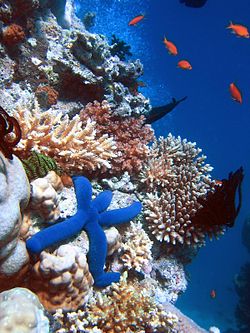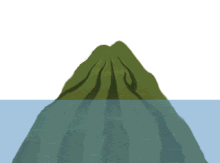Coral reef
A coral reef is a large underwater structure made of dead and living corals. In most healthy reefs, stony corals are predominant. They are built from colonial polyps from the phylum Cnidaria which secrete an exoskeleton of calcium carbonate. The reefs are formed in tropical marine areas (30 degrees north and south of the equator) and between the tropics. The reef acts as the home of many tropical fish and other animals. Coral reefs systems are a major tourism attraction because of their beauty and color of the corals and their many associated animals.


People look at them while snorkeling and diving. One example of a coral reef is in Malaysia at Pulau Tioman, off the State of Pahang. The most famous is the Great Barrier Reef off the East coast of Australia.
Formation
changeMost present-day coral reefs were formed after the last ice age when melting ice caused the sea level to rise and flood the continental shelves. This means they are less than 10,000 years old. As coral reef communities were established on the shelves, they built reefs that grew upwards, keeping pace with the rise in sea level. Reefs that did not keep pace became drowned reefs, covered by so much water that there was insufficient light for further survival.[2]
Coral reefs are also found in the deep sea away from the continental shelves, around oceanic islands and as atolls. The vast majority of these ocean coral islands are volcanic in origin. The few exceptions have tectonic origins where plate movements have lifted the deep ocean floor on the surface.[3]
Conservation
changeCoral reefs are fragile ecosystems. Because corals need warm, sunlit water to live, they often grow close to the top of the water. Being so close to land makes them often be damaged by poisons and dirt that can come from boats and the land nearby. Dirt makes the water cloudier, which makes the sunlight less. Poisons can bleach and kill corals. Also, they are hard for ships to see, but easy to hit, which makes ships often run into the coral, damaging both the boats and coral. Because of this, many countries are trying to lessen the kinds of building that usually happen near beaches that have coral reefs nearby and be more careful about the boats that go around reefs.[4]
-
Brain coral
-
Staghorn coral
-
Spiral wire coral
-
Pillar coral
-
Mushroom coral
-
Maze coral
-
Black coral
-
Fluorescent coral.[5]
References
change- ↑ Animation of coral atoll formation NOAA Ocean Education Service. Retrieved 9 January 2010.
- ↑ Coral reef The Encyclopedia of Earth, Updated February 27, 2009.
- ↑ Darwin, Charles (1842), The structure and distribution of coral reefs. Being the first part of the geology of the voyage of the Beagle, under the command of Capt. Fitzroy, R.N. during the years 1832 to 1836, London: Smith Elder and Co
- ↑ Mulhall M (2007) Saving rainforests of the sea: An analysis of international efforts to conserve coral reefs Archived 2010-01-06 at the Wayback Machine Duke Environmental Law and Policy Forum 19:321–351.
- ↑ Fluorescent coral Archived 2010-06-29 at the Wayback Machine National Geographic.
Further reading
change- Forrester, Graham E.; O'Connell-Rodwell, Caitlin; Baily, Patricia; Forrester, Linda M.; Giovannini, Sandra; Harmon, Lindsay; Karis, Rebecca; Krumholz, Jason; Rodwell, Timothy; Jarecki, Lianna (2011). "Evaluating Methods for Transplanting Endangered Elkhorn Corals in the Virgin Islands". Graham E. Forrester,1,2Caitlin O'Connell-Rodwell,3,4Patricia Baily,5Linda M. Forrester,6Sandra Giovannini,6Lindsay Harmon,6Rebecca Karis,6Jason Krumholz,7Timothy Rodwell,4andLianna Jarecki8. 19 (3). Restoration Ecology, the journal for ecological restoration international: 299–306. doi:10.1111/j.1526-100X.2010.00664.x. S2CID 84912132.